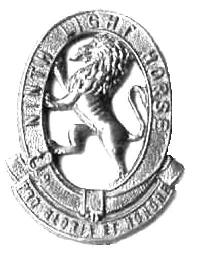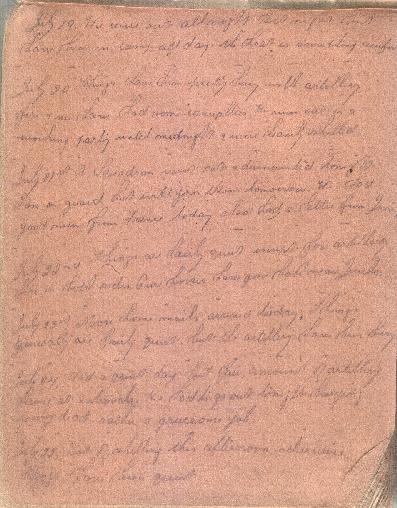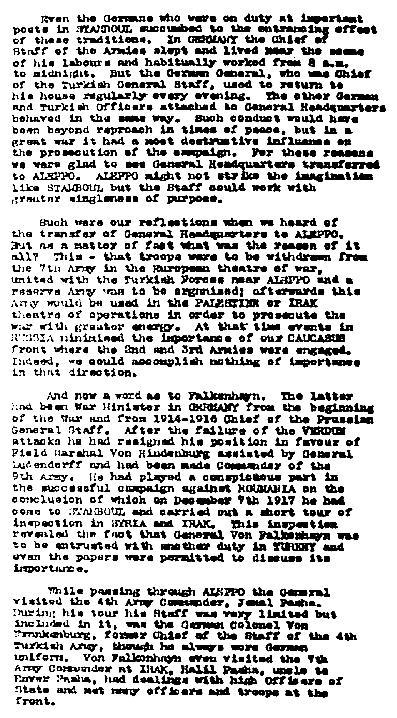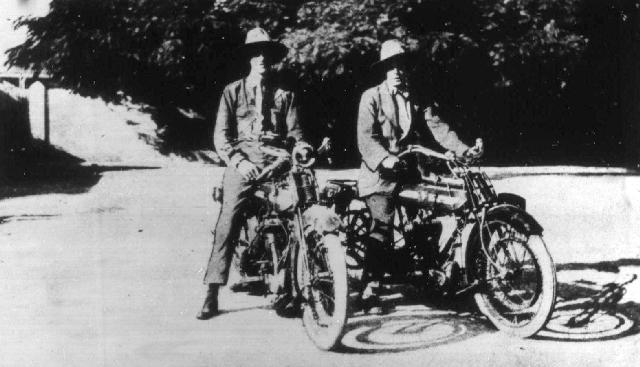TURKS TAKEN BY SURPRISE
Ismet Bey, commanding Beersheba, was watching the British infantry attack from the west, not unduly concerned. He had several infantry battalions and the 3rd Turkish Cavalry Brigade in reserve, and was quite confident that he would not even use these to beat off the British infantry attack. This was about 11 a.m., but 10 minutes later he was amazed to see the plain behind Beersheba covered with horsemen. He sent his aide-de-camp at the gallop to find out the reason for this unexpected turn of events, but that gentleman rode into an Australian patrol and was taken prisoner. Ismet Bey, however, had not long to wait for the answer to his problem, for by 11 30 a.m., the Anzac Mounted Division had dismounted and was advancing against the Turkish defences north-east of the town.
By 1 p.m. the infantry of XXth Corps had captured and secured their first objectives to the west and were consolidating their positions. Everything was going according to plan - at that point. However, progress had slowed down to the east and north east and this was not so good, for although the areas there were under machine-gun and artillery fire from the town it was apparent that the Anzac Mounted Division had possibly dismounted too soon and the Turkish defenders on the hill Tel Saba were now enfilading their advance from the east.
The Australians and New Zealanders of the Anzac Mounted Division were really trained as Mounted Infantry rather than as cavalry for shock action, and they lacked the heavy weapons to support them once they dismounted and took to "Shank's Pony". (The Royal Horse Artillery batteries allotted to the cavalry on a basis of one battery per Brigade had found great difficulty in keeping up with the cavalry during the night march over the rugged terrain and few of the guns were up with the cavalry.) For two sweltering and very thirsty hours the men of the two dismounted divisions (less one Brigade of the Australian Mounted Division) inched their way forward from one rocky ridge to another, from wadi to wadi, slowly getting closer to the Turkish strong points. (Here it is again pointed out that once a horsed regiment dismounted it lost a quarter of its fire-power as each No.3 became the horse-holder for his section.) Shortly after 3 p.m. the Turkish positions on Tel Saba were captured by troops of the Anzac Mounted Division at the point of the bayonet, and the last of the outer defences taken. Three miles away across the wide open plain was Beersheba and its seven wells; but the Turkish inner defences were intact and still practically untouched and in less than two hours it would be dark. To General Harry Chauvel, watching the progress of his troops from the Kassim Zanna ridge, it appeared possible that the coming darkness could easily cheat him of Beersheba — and above all its precious water — as a prize.
At 4p.m. (31st October) the 4th Light Horse Brigade of the Australian Mounted Division was resting and feeding its horses behind Kassim Zanna ridge, which ran roughly north to south about 6 miles east of Beersheba. The Brigade comprised the 4th Light Horse Regiment (Victoria), 11th Light Horse Regiment (Queensland) and the 12th Light Horse Regiment (N.S.W.) but only two regiments were present as the 11th A.L.H. had been detached to watch the left flank of the Division to the south-west. These two regiments, 4th and l2th A.L.H., were comparatively fresh as they had not been involved in the battle since the commencing stages early in the morning. They had, of course, suffered from heat, thirst and flies, but were reasonably rested as far as conditions permitted.
Brigadier-General "Itchy" Grant, commander 4th L.H. Brigade, had spent the afternoon on top of a nearby hill watching the dismounted troopers of the other formations working their way slowly forward across the broken ground to the north. His Divisional Commander. Major-General H.W. Hodgson, came to him shortly after 4 o'clock and told him it was his turn to go in. Together they rode to see General Chauvel at his headquarters some little distance away.
"TAKE TOWN BEFORE DARK!"
General Chauvel had decided that the time had come for an all-out assault if he were to get that precious water for his horses — but he had a difficult decision to make. Would he use his reserve British Yeomanry Brigade or the 4th Australian Light Horse Brigade for this final attack? He was fully aware that the 7th Yeomanry Brigade was trained as cavalry and fully armed with sabres, and that sabres would be a much more useful weapon in a mounted attack, whereas the Australians carried only rifles and bayonets. Finally his mind was made up for him by one major factor - the Australian brigade was nearer at hand and closer to the objective, and time was running out. "Go right in and take the town before dark!" he told Brigadier Grant, and although Chauvel did not directly say "a mounted attack". Grant knew that a mounted shock action was the only way to take Beersheba before nightfall.
Just over an hour's daylight remained and speed was necessary, so Grant sent gallopers with orders for the 4th and l2th Regiments to saddle-up at once and be brought forward by their seconds-in-command to an assembly area south of the track running eastwards from Beersheba. He then galloped forward with two regimental commanders, his Brigade-Major and four orderlies to look for an advanced assembly area closer to the enemy, but if possible one which would not be overlooked and shelled.
It was vital, if the charge were to be successful, that the horses, tired from long hours of waiting in the heat, dust and flies, should not be panicked by shell-fire before the charge commenced. There was little time for any detailed reconnaissance, or to bring up any number of field-guns or machine-guns to support the attack, but General Hodgson sent messages requesting the two nearest batteries of the Royal Horse Artillery to do what they could to assist the Australians. As always, the gallant Horse-Gunners limbered up their guns and galloped forward into action in the open about 2,500 yds from the Turkish trenches.
At the same time the 4th and 12th L.H. Regiments moved from the assembly area about 3,000 yards from their objective, and at 4.30 p.m. trotted forward in Column of Squadrons with Brigade H.Q. right behind them. "Itchy" Grant had decided that each trooper would carry his bayonet in his hand and use it as a short-sword (the 1914-1918 bayonet was much longer, and nastier, than the modern bayonet) and sling his rifle across his back (rifle-buckets were not a general issue with the Light Horse). He had decided that the bayonets would not be fixed to the rifles and used somewhat like a lance as he considered there was too much danger of a trooper losing both if his horse came down and he would thereupon find himself unarmed amongst the enemy.
As the two regiments trotted out of their assembly area into the open they were bombed and machine-gunned by two German planes, but they increased pace and little damage was done. The enemy artillery from Beersheba opened fire at this time but they misjudged the range and most of the shells exploded harmlessly behind the advancing horsemen. As the Lighthorsemen increased their pace to the gallop the machine-gun fire from the Turkish trenches was practically silenced by the magnificently accurate fire of the two R.H.A batteries, who covered the galloping, thundering, yelling mass of Australian horsemen as they swept in clouds of dust towards the Turkish positions and the town beyond.
By this time the daylight was turning in to the short twilight of the East and the decreasing light was lit by flashes of Turkish rifle and artillery fire and the British shells exploding amongst them. Clouds of dust billowed above the charging Australians, reducing visibility and hiding the ground ahead - and also hiding the answer to the dreaded question; Were the Turkish trenches all protected by barbed wire? Also, between the racing horsemen and the town itself ran the Wadi Saba, which had not, obviously, been reconnoitred. Were its bank as steep and the wadi itself as deep as some of those crossed during their approach march on the previous night? If this were the case, then the leading Troops would tumble into ruin and those following crash down on top of them in a turmoil. Aerial photographs had not supplied the answers, and it was probably a good thing that the dust and failing light hid a great deal.
Fortunately the trenches in that particular sector had not been wired, either because the Turks did not expect to be attacked from that desert flank or because there had been insufficient time, or wire, to complete the defences. As the leading squadrons came on the trenches they "put In the hooks" to their horses and leapt over the trenches like steeplechasers, after which some of the troopers threw themselves from their horses and plunged into the trenches to finish off the job there. Others charged right into the second line of defences, leaning down from their saddles to use their bayonets as swords or improvised lances, or firing from the saddle. Over half the Australian total casualties of 64 were sustained during this hand-to-hand fighting in the semi-darkness; the majority of the remainder were wounded before reaching the trenches.
VICTORIOUS HORSEMEN TAKE BEERSHEBA
Within 10 minutes the Turkish trenches were in the hands of the Australians and Grant quickly reorganized his two regiments to gallop straight into the town, capture as many prisoners as possible, and prevent damage to the wells. In the gathering darkness the victorious horsemen swept into Beersheba and through the streets, riding down scattered groups of the enemy and keeping them on the run. Huge flames gushed skywards as the Turks blew up some of their dumps and some of the wells, and the burning railway station added to the glow.
By 6 p.m., two hours after Brigadier Grant had ridden up to General Chauvel to receive his orders for the attack, Beersheba was in British hands, and with its capture the watering of the Desert Mounted Corps and other units was assured, The first part of General Allenby's plan had been accomplished.
The 4th A.L.H. Brigade had captured 1,200 prisoners, 10 field-guns and huge quantities of stores and animals. Ismet Bey, the Turkish commander, had managed to escape by car only minutes before the cheering Australians came thundering through the streets to surround his headquarters.
A great deal of the success of the charge was due to the speed with which it was carried out. It took the Turks by surprise, as It was the first time that a major shock cavalry action had been used against them — and their own cavalry rarely showed much inclination to fight The other cavalry attacks that day had been dismounted actions, the cavalry using their horses purely to carry them forward to forming-up positions, then dismounting and fighting forward on foot. Just before the charge the Turks on that sector had been engaged with the dismounted New Zealand Mounted Rifles on Tel Saba, and not only were they looking in the wrong direction when the Australians galloped at them, but also their rifles were all sighted to Fire at long range. When examined later all the Turkish rifles and what machine-guns that were left were found to be sighted at 800-900 metres or more, and as a result most of the fire had passed over the heads of the charging horsemen.
Quite apart from the vital part they had played in capturing Beersheba, the charge of the 4th A.L.H. Brigade set the standard for the remainder of the campaign.
It had shown that under certain circumstances cavalry could still be used for shock action successfully, and it inspired a spirit of dash and daring which the rest of the cavalry were quick to emulate.
Following Beersheba the Australian Mounted Division (3rd, 4th and 5th Light Horse Brigades) demanded sabres and early in 1918 were finally issued with them (and made good use of them on several occasions), also with rifle buckets, to become armed as true cavalry. However, the Anzac Mounted Division (1st and 2nd Light Horse Brigades and the N.Z. Mounted Rifles Brigade) were never issued with sabres and finished the war as Mounted Infantry.
POST SCRIPT
The writer had the honour of knowing the late General Sir Harry Chauvel quite well, and on the last occasion he talked with the fine old soldier, during lunch at Moonee Valley Races, the subject of Beersheba naturally arose again. Sir Harry said that later he was often condemned because he decided to use his fellow Australians instead of Yeomanry for the charge, and that in doing this he had exhibited prejudice. He was most emphatic that he fully realized a charge by Yeomanry armed with sabres would have been preferable - but this would have necessitated a delay of at least another half an hour to get the Yeomanry brigade forward from their position in reserve, and time was most important. "I suppose I was at fault there, "the fine old soldier admitted, "but I didn’t think the Anzac Division would have been so slow. I suppose the fault was mine in that I didn't decide on a mounted shock attack an hour earlier. If I had done so I most certainly would have sent the Yeomanry in. We simply had to have those wells!”
The post script is the most interesting part of this story in that it is a confession by Chauvel that he actually dithered indecisively subsequent to the fall of Tel el Saba which created further problems for him.









